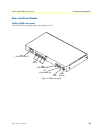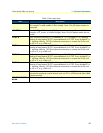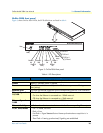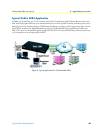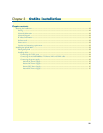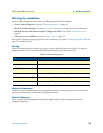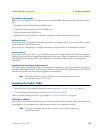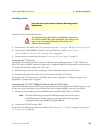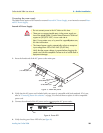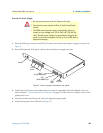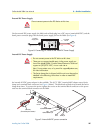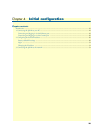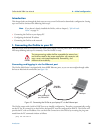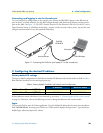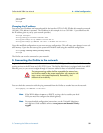
Installing the OnSite 2884 24
OnSite Model 2884 User Manual 3 • OnSite installation
Installing cables
Connect the cables in the following order:
1. Connect the T1/E1 cables to the T1/E1 ports (see Appendix C on page 41 and Appendix D on page 46).
2. Connect the 10/100/1000Base-T Ethernet LAN and WAN (see section “Connecting the
10/100/1000Base-T Ethernet LAN and WAN cables” on page 24)
3. Connect the power mains cable (see section “Connecting the power supply” on page 25)
Connecting the T1/E1 ports
The OnSite comes with one to four T1/E1 ports. These ports are usually connected to a T1/E1 TDM service.
Each T1/E1 port is a RJ-48C receptacle. In most cases, a straight-through RJ-45 can be used to connect the port.
To connect the twisted pair cable to the T1/E1 port:
1. Attach the male connector of the twisted pair cable to the female connector on the OnSite.
2. Attach the other end of the cable to the serial connector on the local T1/E1 unit.
For details on the T1/E1 port pin-out and ISDN cables, refer to Appendix C, “Cabling” on page 43 and
Appendix D, “port pin-outs” on page 47.
Connecting the 10/100/1000Base-T Ethernet LAN and WAN cables
The OnSite 2884 has automatic MDX (auto-crossover) detection and configuration on all Ethernet ports. Any
of the ports can be connected to a host or hub/switch with a straight-through or cross-over wired cable.
1. Connect to the subscriber port of the broadband access modem (Cable, WLL) to ETH 0/0.
Note
The OnSite Ethernet ports operate in Full Duplex mode only. Do not connect
to Half Duplex ports. For best results, use auto-negotiation. Auto negotiation
is mandatory when using 1000BaseT (Gigabit) Ethernet.
2. Connect port ETH 0/1 to your LAN.
For details on the Ethernet port pinout and cables, refer to Appendix C, “Cabling” on page 41 and Appendix
D, “Port pin-outs” on page 46.
Do not work on the system or connect or disconnect cables during periods of
lightning activity.
The interconnecting cables shall be acceptable for external use
and shall be rated for the proper application with respect to volt-
age, current, anticipated temperature, flammability, and
mechanical serviceability.
WARNING
CAUTION



